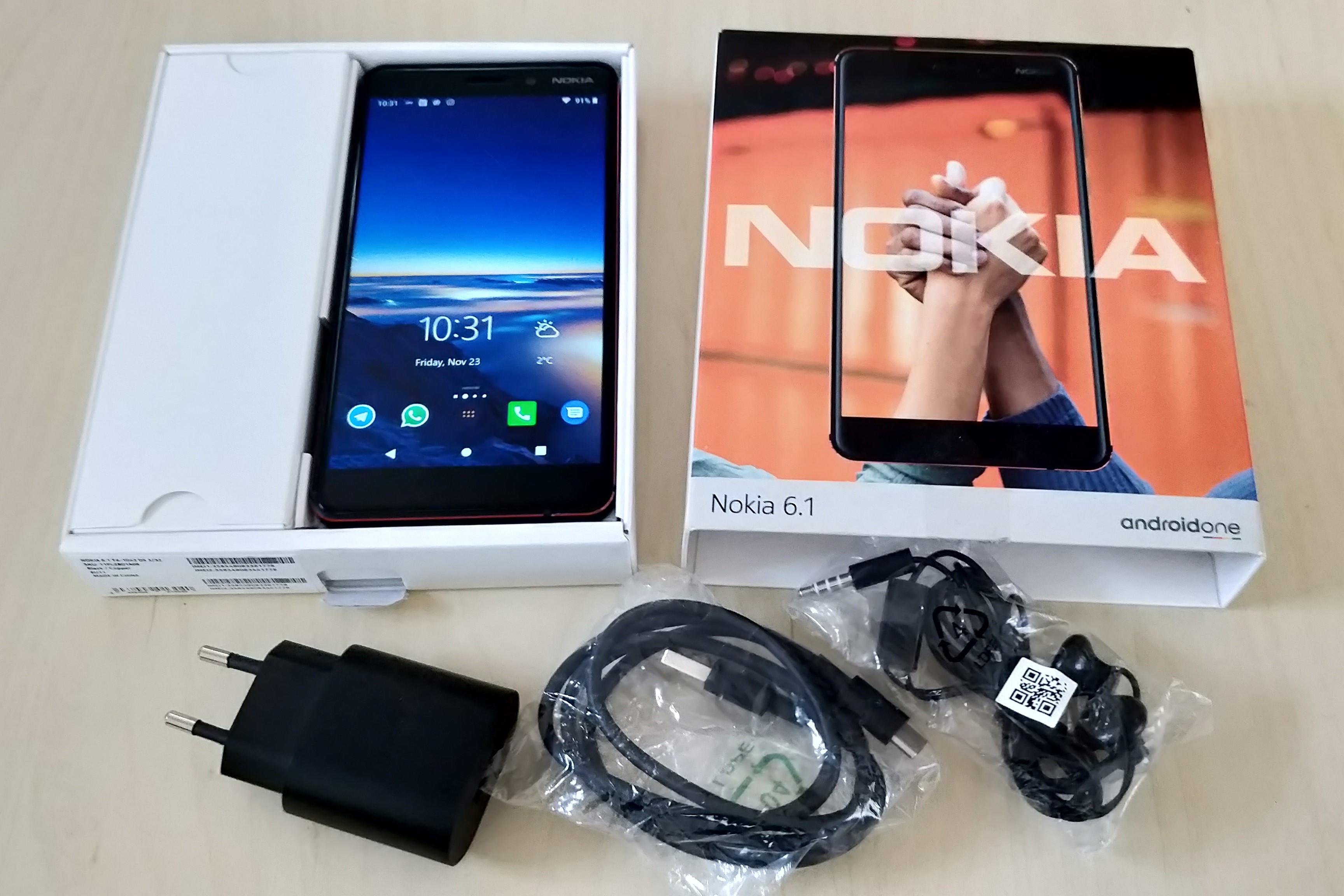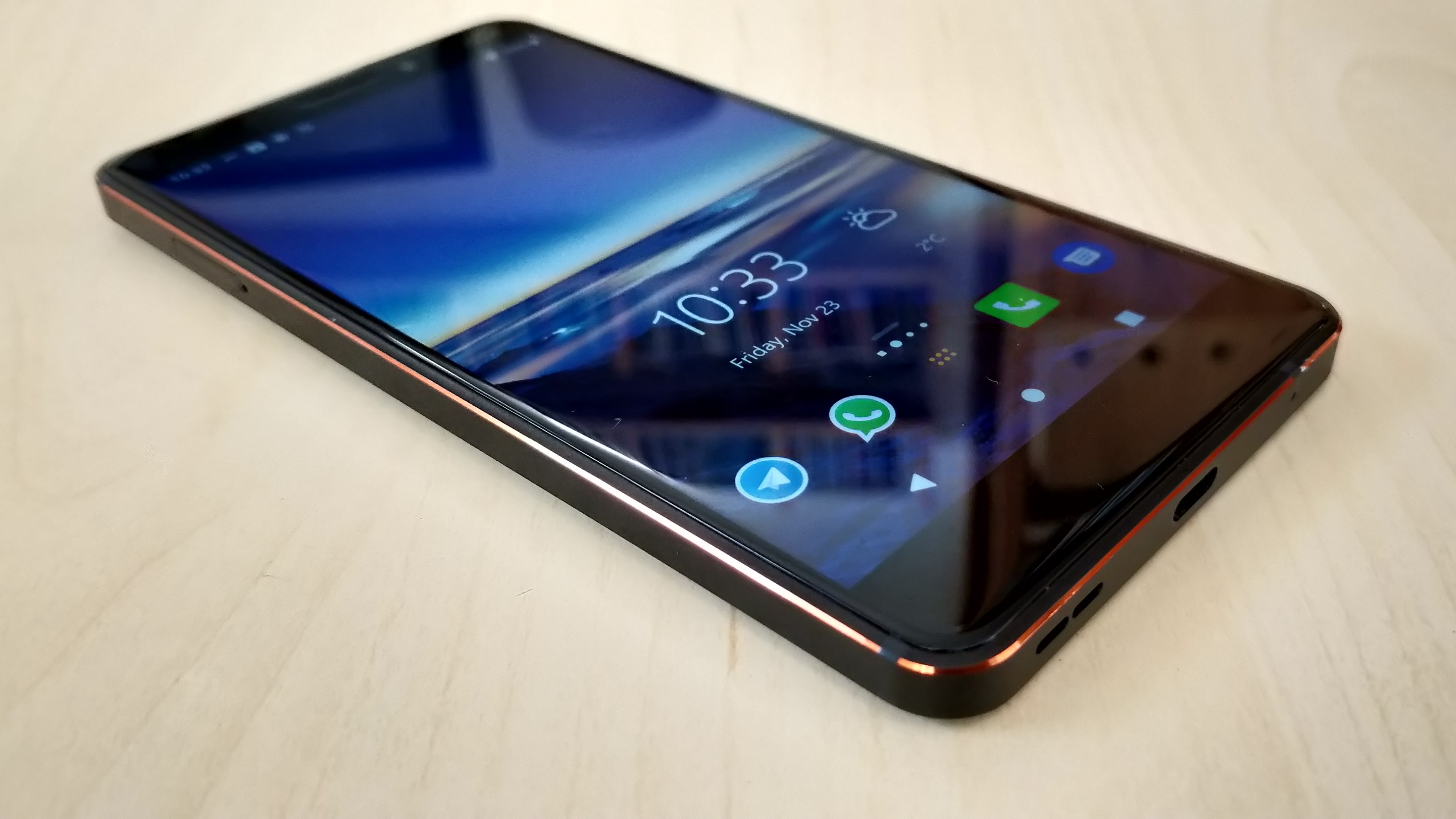Ever since the resurrection of the infamous Nokia brand I’ve kept close contact with the PR people of HMD Global, so I got from them a review specimen of the follow up to their bestseller from last years debut portfolio of Android One phones: the Nokia 6.1 formerly known as the Nokia 6 (2018). Let’s have a look.
In the box
Of course you’ll find the Nokia 6.1 phone, then the standard USB power-plug, a USB-C charging cable and (I don’t get why they still supply these in 2018) a set of simple wired in-ear headphones. No case is included (like the 7 plus did) and the box is the simple well known downward sliding retail box:
The specs
The Nokia 6.1 has seen an upgrade mainly on the SOC front, bumping that underpowered Snapdragon 430 op to a Snapdragon 630, significantly increasing it’s overall performance. Apart from that most of the changes are to be found in the design of the phone; moving the fingerprint sensor from the front to the back of the phone and finally adopting the USB-C standard for charging and USB-connection. Full specs below (thanks to GSMarena website):
| Network | Technology | GSM / HSPA / EVDO / LTE |
|---|---|---|
| 2G bands | GSM 850 / 900 / 1800 / 1900 – SIM 1 & SIM 2 | |
| 3G bands | HSDPA 850 / 900 / 1900 / 2100 | |
| CDMA2000 1xEV-DO – Hong Kong, Taiwan | ||
| 4G bands | LTE band 1(2100), 3(1800), 5(850), 7(2600), 8(900), 20(800), 28(700), 38(2600), 40(2300), 41(2500) – EMEA & APAC | |
| LTE band 2(1900), 3(1800), 4(1700/2100), 5(850), 7(2600), 12(700), 17(700), 20(800), 28(700), 38(2600) – LATAM | ||
| LTE band 1(2100), 3(1800), 4(1700/2100), 5(850), 7(2600), 8(900), 20(800), 28(700), 34(2000), 38(2600), 39(1900), 40(2300), 41(2500) – Hong Kong, Taiwan | ||
| Speed | HSPA 42.2/5.76 Mbps, LTE Cat4 150/50 Mbps | |
| GPRS | Yes | |
| EDGE | Yes |
| Launch | Announced | 2018, January |
|---|---|---|
| Status | Available. Released 2018, April |
| Body | Dimensions | 148.8 x 75.8 x 8.2 mm (5.86 x 2.98 x 0.32 in) |
|---|---|---|
| Weight | 172 g (6.07 oz) | |
| Build | Front glass, aluminum body (6000 series) | |
| SIM | Hybrid Dual SIM (Nano-SIM, dual stand-by) |
| Display | Type | IPS LCD capacitive touchscreen, 16M colors |
|---|---|---|
| Size | 5.5 inches, 82.6 cm2 (~73.2% screen-to-body ratio) | |
| Resolution | 1080 x 1920 pixels, 16:9 ratio (~403 ppi density) | |
| Protection | Corning Gorilla Glass 3 |
| Platform | OS | Android 8.1 (Oreo), upgradable to Android 9.0 (Pie); Android One |
|---|---|---|
| Chipset | Qualcomm SDM630 Snapdragon 630 (14 nm) | |
| CPU | Octa-core 2.2 GHz Cortex-A53 | |
| GPU | Adreno 508 |
| Memory | Card slot | microSD, up to 256 GB (uses SIM 2 slot) |
|---|---|---|
| Internal | 32/64 GB, 3/4 GB RAM |
| Main Camera | Single | 16 MP, f/2.0, 27mm (wide), 1.0µm, PDAF |
|---|---|---|
| Features | Zeiss optics, dual-LED dual-tone flash, panorama, HDR | |
| Video | 2160p@30fps, 1080p@30fps |
| Selfie camera | Single | 8 MP, f/2.0, 1/4″, 1.12µm |
|---|---|---|
| Video | 1080p@30fps |
| Sound | Loudspeaker | Yes |
|---|---|---|
| 3.5mm jack | Yes | |
| – Active noise cancellation with dedicated mic |
| Comms | WLAN | Wi-Fi 802.11 a/b/g/n/ac, Wi-Fi Direct, hotspot |
|---|---|---|
| Bluetooth | 5.0, A2DP, LE | |
| GPS | Yes, with A-GPS, GLONASS, BDS | |
| NFC | Yes | |
| Radio | FM radio with RDS | |
| USB | 2.0, Type-C 1.0 reversible connector |
| Features | Sensors | Fingerprint (rear-mounted), accelerometer, gyro, proximity, compass |
|---|---|---|
| – Fast battery charging 18W: 50% in 30 min |
| Battery | Non-removable Li-Ion 3000 mAh battery | |
|---|---|---|
| Stand-by | Up to 507 h (3G) | |
| Talk time | Up to 16 h (3G) | |
| Music play | Up to 119 h |
| Misc | Colors | Black/Copper, White/Iron, Blue/Gold |
|---|---|---|
| SAR EU | 0.94 W/kg (head) 1.82 W/kg (body) | |
| Price | About 230 EUR |
Design of the hardware
The Nokia 6.1 is once again made of aluminium unibody design (this time however without the multilayer coating of the 7 plus) with diamond cut edges in a contrasting colour (red copper in this casue of the matte black model), with an all glass front comprising the 5,5 inch FHD LCD screen with 16:9 aspect ratio. Let’s have a small picture walk-around:
The front of the Nokia 6.1 with its slightly rounded edges of the screen, nice blending into the body, lined by that diamond-cut edge. The glass has a very good oleophobic coating keeping it nicely fingerprint free. The bottom of the 6.1 shows the USB-C port and the single downward firing speaker.
The rear of the 6.1 with the, in my humble opinion, totally unnecessary but HMD standard block of text with the Android One and HMD branding and the CE certification badge, etc. In the centre you’ll see the Nokia logo in the same copper accent as the diamond-cut edges, with above it the fingerprintscanner and the single Zeiss lens camera and its LED flash.
On the side of the 6.1 you can see the power button with directly above it the volume rocker.
The view more from the top shows the headphone jack, a better look at the side buttons and clearly visible along the top edges of the phone the antenna lines. The other side of the phone features the SIM tray (which is also from aluminium) that can hold either dual nano SIM’s or a single primary SIM and an additional Micro-SD card.
I’m a bit torn about the design of the 6.1 actually, because I really want to like it and I do have to say that the whole phone is really well built and feels like a quality product. The diamond-cut edges with gold or copper accents give it a very nice premium touch as well.
But some design choices have been made that I simply don’t like. First there is the extreme slipperiness of the matte aluminium frame in combination with its wide 16:9 ratio form factor: it is just not nice to hold. The weight being the only factor here, that’s done right. The fingerprint scanner turned out to be placed too low on the back and has a small surface, making unlocking quite a hit and miss experience.
And then these buttons on the side: they are way too small, to close to another and hardly give any tactile feedback when pressed. Because the buttons are so narrow and shallow, you’ll have a hard time pressing the right one (if at all) just by touching/feeling the narrow side of the phone. One almost has to look where the buttons are and it made me dislike handling this phone, despite its quality build.
Performance
In using the phone I found no problems with at all. The upgrade from a 430 to 630 Snapdragon is really noticable and gives this 6.1 the responsiveness that the 6 should have had from the start. Even a demanding flagshio-user like me will have no problems with the speed of the 6.1, save some really heavy apps that need a bit more time to start.
The storage of 32GB is adequate and IMHO the minimum for a full feature Android phone these days if you don’t want to run into diskspace problems while running system updates for instance later on.
The screen is good, but not fantastic: simply the level of quality you may expect in this price segment. It has, like mentioned before, a great oleophobic coating, suppressing fingerprints very well, and even though it’s an LCD it has vibrant colours and good enough readability in sunlight. This screen has one downside to it which is common to most Nokia/HMD Android phones: it’s colour reproduction is on the cool side, soimetimes even downright too blue when compared to other smarphones. When the Night Mode gets activated this shifts to completely the opposite side of the spectrum; being way too red. Luckily this Night Mode can be tweaked from the settings to appear less red, so the default setting of this is way too aggressive.
Sound in good as well. In calls the earpice has excellent volume and clarity as well as the quality of the call connection. The external speaker is extremely loud and a bit too tinny as you may expect, but no bad points here.
One of the strong points of HMD Globals Nokia’s is their battery life, and the 6.1 doesn’t disappoint either in this field: it will easily last you a full day of quite heavy use, and if you don’t belong to the social media addicted part of the worlds population, it’ll likely last you almost two days like Nokia advertises.
The camera
The camera is the main disappointment of the Nokia 6.1. I realise this is a mid-range phone, of even low-end almost, but in my opinion that does not excuse delivering such a mediocre camera. To most people the camera is the main USP of any smartphone and is also one of its most used features (in this selfie-centric age of history). The newer Nokia 7.1 (that I have also reviewed recently and will appear shortly) that sells for almost the same price at the moment of writing this review, does infinitely better in this area.
Low-light pictures of the Nokia 6.1 are milky greyish in appearance and the extremely aggressive noise-reduction algorithm destroys any sharpness that was left after your attempts to capture a sharp picture without image stabilisation.
In sunlight or regular daylight conditions the pictures are OK, but nothing more than that. The maximum level of detail is still not up there with competitors, even during these daylight conditions due to some bad over-processing of the images. The only good news here is that it does preform slightly better than the phone it succeeds and that maybe some software upgrades (both OS/firmware and the camera app) may improve it a bit over time.
Anyway, I’ve got some examples for you down below:
Verdict
The Nokia 6.1 (or 6 [2018]) fixes almost all problems the original 6 had, like a badly underpowered processor and GPU, in the mean time keeping all that was good, like the unibody aluminium body, Android One and competitive pricing. Pricing is about the same as the 6, which is reasonable for what you’ll get. However, with the recent 7.1 cashback promotions, the 7.1 has become the obvious better choice here; fixing both my design gripes and the camera’s performance for now almost the same retail price.
So in the end I am a bit reluctant to recommend this 6.1 as is it has already been surpassed by several models from the same brand, and the incredibly fast pace in which HMD Global refreshes the whole range makes this phone already almost forgotten due to better performing successors.
Pros:
- Build quality/design
- Battery life
- Call quality
- USB-C port
- Android One
- Performance in relation to price
Cons:
- 16:9 screen and general ergonomics
- Camera performance is disappointing









